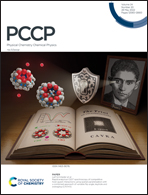Identification of the probable structure of the sAPPα-GABABR1a complex and theoretical solutions for such cases†
Abstract
Amyloid precursor protein (APP) is the core of the pathogenesis of Alzheimer's disease (AD). Existing studies have shown that the soluble secreted APP (sAPPα) fragment obtained from the hydrolysis of APP by α-secretase has a synaptic function. Thereinto, a nine-residue fragment (APP9mer) of the extension domain region of sAPPα can bind directly and selectively to the N-terminal sushi1 domain (SD1) of the γ-aminobutyric acid type B receptor subunit 1a (GABABR1a) protein, which can influence synaptic transmission and plasticity by changing the GABABR1a conformation. APP9mer is a highly flexible, disordered region, and as such it is difficult to experimentally determine the optimal APPmer-SD1 binding complex. In this study we constructed two types of APP9mer-SD1 complexes through molecular docking and molecular dynamics simulation, aiming to explore the recognition function and mechanism of the specific binding of APP9mer with SD1, from which the most probable APPmer-SD1 model conformation is predicted. All the data from the analyses of RMSD, RMSF, PCA, DCCM and MM/PBSA binding energy as well as comparison with the experimental dissociation constant Kd suggest that 2NC is the most likely conformation to restore the crystal structure of the experimental APP9mer-SD1 complex. Of note, the key recognition residues of APP9mer are D24, D25, D27, W29 and W30, which mainly act on the 9–45 residue domain of SD1 (consisting of two loops and three short β-chains at the N-terminus of SD1). The mini-model with key residues identified establishes the molecular basis with deep insight into the interaction between APP and GABABR1a and provides a target for the development of therapeutic strategies for modulating GABABR1a-specific signaling in neurological and psychiatric disorders. More importantly, the study offers a theoretical solution for how to determine a biomolecular structure with a highly flexible, disordered fragment embedded within. The flexible fragment involved in a protein structure has to be deserted usually during the structural determination with experimental methods (e.g. X-ray crystallography, etc.).



 Please wait while we load your content...
Please wait while we load your content...